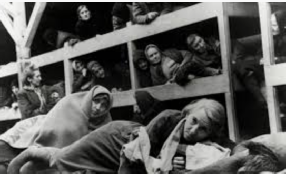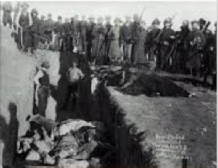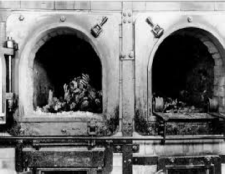|
CLICK BUTTON TO GO |
|
|
|
|
|
|
|
|
|
|
|
|
|
Videos |
|
|
|
|
|
|
|
|
|
|
|
|
|
PART 1 T O P I C |
|
|
|
|
|
|
|
|
|
|
|
|
|
|
|
|
|
|
JewishWikipedia.info
THE
INCREDIBLE
STORY OF THE JEWISH PEOPLE
THE
INCREDIBLE
STORY OF THE JEWISH PEOPLE
VIDEOS
JEWISH RESISTANCE DURING THE HOLOCAUST



Go to Rescuers who defied the Nazis
JEWISH RESISTANCE DURING THE HOLOCAUST
Yad Vashem, 2017 (15.29)
This Educator Video Toolbox is aligned to Echoes and Reflections, a comprehensive Holocaust education program that delivers professional development and a rich array of multimedia resources for middle and high school teachers.
This video complements Lesson 6: Resistance. It addresses key historical context, supports your teaching, and provides a methodological and pedagogical framework to help you effectively teach the subject of spiritual and armed resistance during the Holocaust.
A common question when we’re studying about the Holocaust is, “Why didn’t the Jews resist?” But they did. In this video we discuss different forms and types of resistance, both spiritual and armed. In the unprecedented inhumanity of the Holocaust there were Jews who found the strength and the courage, both physical and spiritual, to retain their humanity and resist hopelessness and dehumanization. The story of their resistance is a human story that shows the heights that human beings can reach even in the depths of despair.
912 DAYS OF THE WARSAW GHETTO
DANIEL SZTEJNHAUER 2016 (36.36)
Text from Pavel Levin 2013 (36.36) that has been withdrawn
The Warsaw Ghetto was established by the German Governor-General Hans Frank on October 16, 1940. Frank ordered Jews in Warsaw and its suburbs rounded up and herded into the Ghetto. At this time, the population in the Ghetto was estimated to be 400,000 people, about 30% of the population of Warsaw; however, the size of the Ghetto was about 2.4% of the size of Warsaw.
The construction of the ghetto wall started on April 1, 1940, but the Germans closed the Warsaw Ghetto to the outside world on November 16 that year. The wall was typically 3 m (9.8 ft) high and topped with barbed wire. Escapees could be shot on sight. The borders of the ghetto changed many times through the next years.
The ghetto was divided by Chłodna Street, which due to its importance (Warsaw's major street leading to the east) was excluded from it. The area south of Chłodna was known as "Small Ghetto", while the area north of this street -- "Large Ghetto". Those two parts were connected by Żelazna Street (special gate was built at its intersection with Chłodna Street). In January 1942 a wooden footbridge, which after the war became one of the symbols of the Holocaust, was built there to ease pedestrian traffic. The first commissioner of the Warsaw ghetto was his chief organizer SA-Standartenführer Waldemar Schön. He was succeeded in May 1941 by Heinz Auerswald.
On January 18, 1943, after almost four months without any deportations, the Germans suddenly entered the Warsaw ghetto intent upon a further deportation. Within hours, some 600 Jews were shot and 5,000 others rounded up.
The Germans expected no resistance, but preparations to resist had been going on since the previous autumn. The first instances of Jewish armed resistance began that day. The Jewish fighters had some success: the expulsion stopped after four days and the ŻOB and ŻZW resistance organizations took control of the Ghetto, building shelters and fighting posts and operating against Jewish collaborators.
The final battle started on the eve of Passover of April 19, 1943, when a Nazi force consisting of several thousand troops entered the ghetto. After initial setbacks, the Germans under the field command of Jürgen Stroop systematically burned and blew up the ghetto buildings, block by block, rounding up or murdering anybody they could capture. Significant resistance ended on April 28, and the Nazi operation officially ended in mid-May, symbolically culminating with the demolition of the Great Synagogue of Warsaw on May 16. According to the official report, at least 56,065 people were killed on the spot or deported to German Nazi concentration and death camps, most of them to Treblinka.
Opening screen of Animated Map Yad Vashem
In the face of Nazi terror, many Jews resisted the Germans and their collaborators. Underground resistance movements developed in over 100 ghettos in Nazi-occupied eastern Europe. Further, under the most adverse conditions, Jewish prisoners succeeded in initiating uprisings in some of the Nazi camps. Jewish partisan units operated in France, Belgium, the Ukraine, Belorussia, Lithuania, and Poland. Jews also fought in general French, Italian, Yugoslav, Greek, and Soviet resistance organizations. While organized armed resistance was the most direct form of opposition to the Nazis, resistance also included escape, hiding, cultural activity, and other acts of spiritual preservation.
JEWISH RESISTANCE TO
THE HOLOCAUST
Karl Qualls 2018 (10.01)
This video explains the importance of using a broad definition of resistance that includes armed, unarmed, group, and individual defiance when looking at Jewish resistance to the Holocaust. Through specific examples, we have attempted to show the many ways Jews resisted the Nazis, from the armed and unarmed group resistance of the Bielski brothers to the unarmed individual resistance of people like Frank Bleichman
and Bela Chazan Yaari.
JEWISH RESISTANCE
DURING THE HOLOCAUST
Andrew Steiner
Emeritus Professor Konrad Kwiet
Sydney Jewish Museum 2013 (22.34)
JEWISH RESISTANCE DURING THE HOLOCAUST -
Dr. Steven Katz
uwaterloo 2015 (1.37.10)
JEWISH PARTISANS - RESISTANCE BASICS COURSE FOR STUDENTS
JewishPartisans 2015 (30.25)
The Jewish Partisan Educational Foundation's introduction to the Jewish partisans who fought against the Nazis and their collaborators
during World War II
for students - grades 6-12.
Please visit http://www.jewishpartisans.org
for more information and educational tools.
